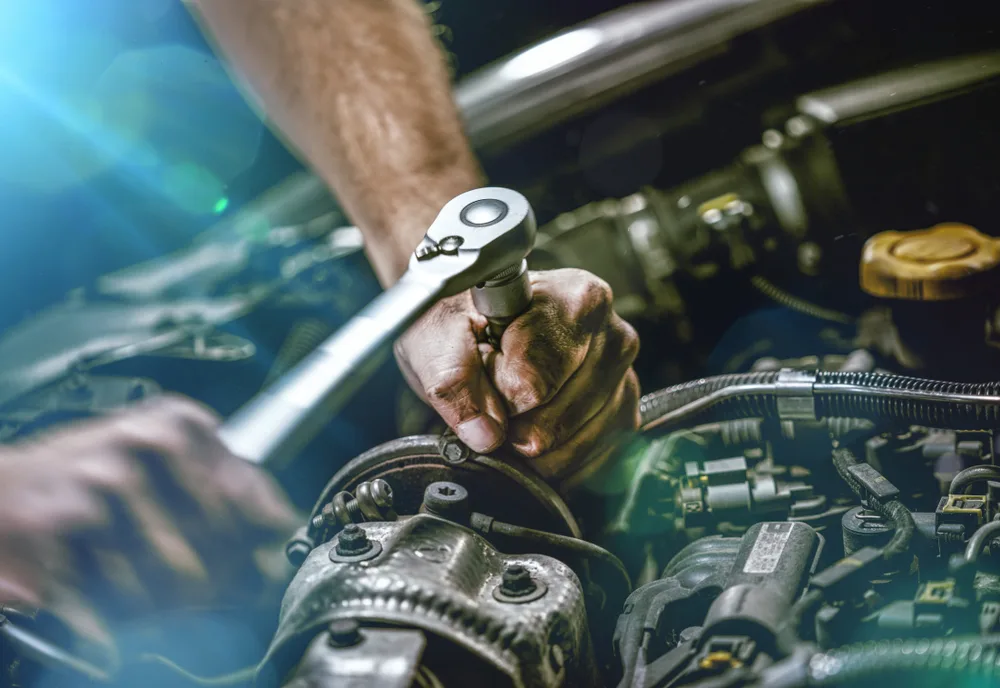Every driver should know some basic car repairs to handle common problems on the road. Learning how to change a flat tire, jump-start a battery, and replace windshield wipers can save both time and money. It also makes driving safer. Knowing how to check and fill up car fluids, and how to change headlights and taillights, helps drivers deal with emergencies on their own. These important skills make sure drivers are not stuck or have to spend a lot of money on help. So, what are the first steps to getting good at these key repairs?
Key Takeaways
- Change a flat tire: Ensure safety, use jack and lug wrench, replace with spare.
- Jump-start a dead battery: Properly connect and disconnect jumper cables.
- Replace windshield wipers: Remove old blades, install new ones, and test.
- Check and top up fluids: Regularly maintain engine oil, coolant, brake, and washer fluids.
- Replace headlights and taillights: Use correct tools to replace bulbs and ensure they work.
Changing a Flat Tire
Changing a flat tire is an important skill every driver should master to guarantee they’re never stranded on the side of the road. The process starts by making sure the vehicle is on a flat, stable surface and the hazard lights are on. After locating the spare tire, jack, and lug wrench, they should place the jack under the vehicle’s frame near the flat tire. It’s essential to consult the owner’s manual to verify the correct jacking point.
Next, they need to slightly loosen the lug nuts with the lug wrench, turning counterclockwise. Once the nuts are loosened, they should jack up the car until the flat tire is about six inches off the ground. Fully remove the lug nuts and the flat tire, then align the spare tire with the lug bolts. Tighten the lug nuts by hand before lowering the vehicle.
After the car is back on the ground, they should use the lug wrench to fully tighten the nuts in a star pattern to ensure even pressure. Finally, stow away the flat tire and tools, and check the spare tire pressure. With this knowledge, they’re prepared to handle unexpected flats confidently.
Jump-Starting a Battery
After mastering how to handle a flat tire, every driver should also be equipped with the knowledge to jump-start a dead battery. It’s an essential skill that guarantees you’re never stranded and can help others in need.
First, locate the dead battery and a working vehicle with a good battery. Position both cars close enough for the jumper cables to reach but make sure they don’t touch. Turn off both vehicles and connect the red (positive) cable to the positive terminal of the dead battery. Attach the other end of the red cable to the positive terminal of the working battery.
Next, connect the black (negative) cable to the negative terminal of the working battery. Attach the other end of the black cable to an unpainted metal surface on the dead car, away from the battery. This acts as a ground, reducing the risk of sparks.
Start the working vehicle and let it run for a few minutes before attempting to start the dead car. Once the dead car starts, let both run for a few minutes before disconnecting the cables in reverse order: black from the grounded surface, black from the working battery, red from the dead battery, and finally, red from the working battery.
Replacing Windshield Wipers
Swapping out old windshield wipers for new ones is a necessary task that guarantees clear visibility during adverse weather conditions. To begin, drivers should lift the wiper arms away from the windshield until they lock in an upright position. Many wiper blades have a small tab where the blade meets the wiper arm. By pressing this tab, the blade releases and can be slid off the arm.
Next, it’s important to confirm that the new wiper blades match the length of the old ones. Most packaging provides a guide, but measuring beforehand ensures a correct fit. Align the new blade with the wiper arm and slide it into the hook until it clicks securely into place. Lower the wiper arm back onto the windshield gently to avoid cracking the glass.
Testing the new wipers is essential. Turn them on and check for smooth, streak-free operation. If they’re not functioning correctly, double-check the installation. Properly functioning wipers are necessary for safe driving, especially in rain and snow.
Replacing windshield wipers empowers drivers, creating a sense of self-reliance and community among those who value maintaining their vehicles. It’s a simple yet essential skill that every driver can master.
Checking and Topping Up Fluids
Ensuring a vehicle runs smoothly requires regular checks of its various fluids, including engine oil, coolant, brake fluid, and windshield washer fluid. Each of these plays an important role in the car’s performance and safety.
Regularly checking engine oil levels helps prevent engine wear and overheating. Drivers should use the dipstick, making sure the oil level is between the minimum and maximum marks. If it’s low, top it up with the recommended oil type.
Coolant is essential for maintaining the engine’s temperature. To check it, locate the coolant reservoir and confirm the level is between the ‘low’ and ‘high’ marks. Only open the cap when the engine is cool to avoid burns. Adding a 50/50 mix of coolant and water is typically best.
Brake fluid is necessary for safe braking. The reservoir is usually located near the back of the engine bay. Confirm the level is within the marked range. If it’s low, top it up with the appropriate brake fluid type, but avoid overfilling.
Lastly, for clear visibility, regularly check windshield washer fluid. Simply locate the reservoir, usually marked with a windshield icon, and fill it up as needed. Regular fluid checks foster a sense of security and community on the road.
Replacing Headlights and Taillights
Replacing headlights and taillights is an essential task that greatly enhances vehicle safety and visibility on the road. First, gather the necessary tools: a screwdriver, replacement bulbs, and possibly gloves to prevent oils from touching the bulbs.
Locate the headlight or taillight housing, usually accessible from the engine bay or trunk. Remove the screws or clips holding the housing in place.
Once the housing is open, twist or unclip the old bulb to remove it. Before inserting the new bulb, check for any signs of corrosion or damage in the socket. If all looks good, insert the new bulb carefully, ensuring it’s securely in place. Reattach the housing and tighten any screws or clips.
Testing the new lights is important. Turn on the headlights and taillights to make sure they’re functioning correctly. If they don’t light up, double-check the connections and the bulb’s orientation.
Frequently Asked Questions
How Do I Diagnose Engine Overheating Issues?
To diagnose engine overheating, first check the coolant level and look for leaks. Inspect the radiator and hoses for blockages. Confirm the thermostat and water pump function correctly, and verify the cooling fan operates as needed.
What Should I Do if My Car’s Brakes Start Squeaking?
If their car’s brakes start squeaking, they should inspect the brake pads for wear. Replacing worn pads or applying brake lubricant can often address the noise and guarantee the brakes function properly, enhancing safety and performance.
How Can I Tell if My Car’s Alignment Is Off?
He can tell if his car’s alignment is off by checking for uneven tire wear, pulling to one side while driving, or a crooked steering wheel. It’s essential to address alignment issues promptly for safety and performance.
What Are the Signs of a Failing Alternator?
A failing alternator shows signs like dimming headlights, a dead battery, or strange noises. Drivers might notice electrical issues, dashboard warning lights, or a burning rubber smell. Address it promptly to avoid getting stranded.
How Do I Fix a Minor Dent or Scratch on My Car?
To fix a minor dent, he should use a hairdryer and compressed air. For scratches, he can apply rubbing compound and polish. This process guarantees his car stays looking sharp without breaking the bank.
Conclusion
In mastering basic DIY car repairs, drivers can greatly enhance their safety and independence on the road. By learning to change a flat tire, jump-start a battery, replace windshield wipers, check and top up fluids, and replace headlights and taillights, they’re equipped to handle common roadside issues.
Not only does this practical knowledge save time and money, but it also instills confidence, ensuring a smoother and more secure driving experience. Regular maintenance is within every driver’s reach.



